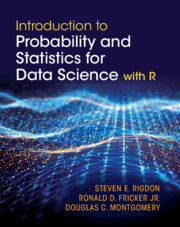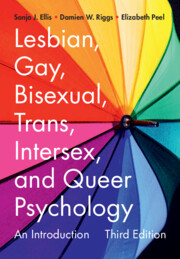Refine search
Actions for selected content:
37059 results in Cambridge Textbooks
Index
-
- Book:
- East Asian International Relations
- Published online:
- 28 November 2024
- Print publication:
- 19 December 2024, pp 350-362
-
- Chapter
- Export citation
Part III - East Asia since 1945
-
- Book:
- East Asian International Relations
- Published online:
- 28 November 2024
- Print publication:
- 19 December 2024, pp 123-309
-
- Chapter
- Export citation

Introduction to Probability and Statistics for Data Science
- with R
-
- Published online:
- 13 December 2024
- Print publication:
- 14 November 2024
-
- Textbook
- Export citation

Lesbian, Gay, Bisexual, Trans, Intersex, and Queer Psychology
- An Introduction
-
- Published online:
- 12 December 2024
- Print publication:
- 12 December 2024
-
- Textbook
- Export citation

Groups
- Theory and Experience
-
- Published online:
- 12 December 2024
- Print publication:
- 05 December 2024
-
- Textbook
- Export citation
3 - Energetics
-
- Book:
- Fundamentals of Turbulent Flows
- Published online:
- 09 January 2025
- Print publication:
- 12 December 2024, pp 86-108
-
- Chapter
- Export citation
5 - The Scales of Turbulent Motion
-
- Book:
- Fundamentals of Turbulent Flows
- Published online:
- 09 January 2025
- Print publication:
- 12 December 2024, pp 140-171
-
- Chapter
- Export citation
9 - Numerical Considerations for High-Fidelity Turbulence Simulations
-
- Book:
- Fundamentals of Turbulent Flows
- Published online:
- 09 January 2025
- Print publication:
- 12 December 2024, pp 254-270
-
- Chapter
- Export citation
6 - Children and Parenting
- from Part III - Lifespan Changes to Families and Relationships
-
- Book:
- Lesbian, Gay, Bisexual, Trans, Intersex, and Queer Psychology
- Published online:
- 12 December 2024
- Print publication:
- 12 December 2024, pp 115-135
-
- Chapter
- Export citation
Figures
-
- Book:
- Lesbian, Gay, Bisexual, Trans, Intersex, and Queer Psychology
- Published online:
- 12 December 2024
- Print publication:
- 12 December 2024, pp x-xi
-
- Chapter
- Export citation
Reviews
-
- Book:
- Fundamentals of Turbulent Flows
- Published online:
- 09 January 2025
- Print publication:
- 12 December 2024, pp ii-ii
-
- Chapter
- Export citation
Contents
-
- Book:
- Fundamentals of Turbulent Flows
- Published online:
- 09 January 2025
- Print publication:
- 12 December 2024, pp vii-x
-
- Chapter
- Export citation
Part IV - Health and Marginalisation
-
- Book:
- Lesbian, Gay, Bisexual, Trans, Intersex, and Queer Psychology
- Published online:
- 12 December 2024
- Print publication:
- 12 December 2024, pp 199-288
-
- Chapter
- Export citation
Reviews
-
- Book:
- Lesbian, Gay, Bisexual, Trans, Intersex, and Queer Psychology
- Published online:
- 12 December 2024
- Print publication:
- 12 December 2024, pp ii-ii
-
- Chapter
- Export citation
Acknowledgements
-
- Book:
- Lesbian, Gay, Bisexual, Trans, Intersex, and Queer Psychology
- Published online:
- 12 December 2024
- Print publication:
- 12 December 2024, pp xx-xx
-
- Chapter
- Export citation
3 - Sex, Gender, and Sexualities in Psychology
- from Part I - History and Context
-
- Book:
- Lesbian, Gay, Bisexual, Trans, Intersex, and Queer Psychology
- Published online:
- 12 December 2024
- Print publication:
- 12 December 2024, pp 38-62
-
- Chapter
- Export citation
12 - Challenges and Opportunities to Health and Well-Being
- from Part IV - Health and Marginalisation
-
- Book:
- Lesbian, Gay, Bisexual, Trans, Intersex, and Queer Psychology
- Published online:
- 12 December 2024
- Print publication:
- 12 December 2024, pp 246-268
-
- Chapter
- Export citation
Copyright page
-
- Book:
- Fundamentals of Turbulent Flows
- Published online:
- 09 January 2025
- Print publication:
- 12 December 2024, pp iv-iv
-
- Chapter
- Export citation
4 - Spectral Description of Turbulence
-
- Book:
- Fundamentals of Turbulent Flows
- Published online:
- 09 January 2025
- Print publication:
- 12 December 2024, pp 109-139
-
- Chapter
- Export citation
10 - Prejudice, Discrimination, and Mental Health
- from Part IV - Health and Marginalisation
-
- Book:
- Lesbian, Gay, Bisexual, Trans, Intersex, and Queer Psychology
- Published online:
- 12 December 2024
- Print publication:
- 12 December 2024, pp 201-224
-
- Chapter
- Export citation
